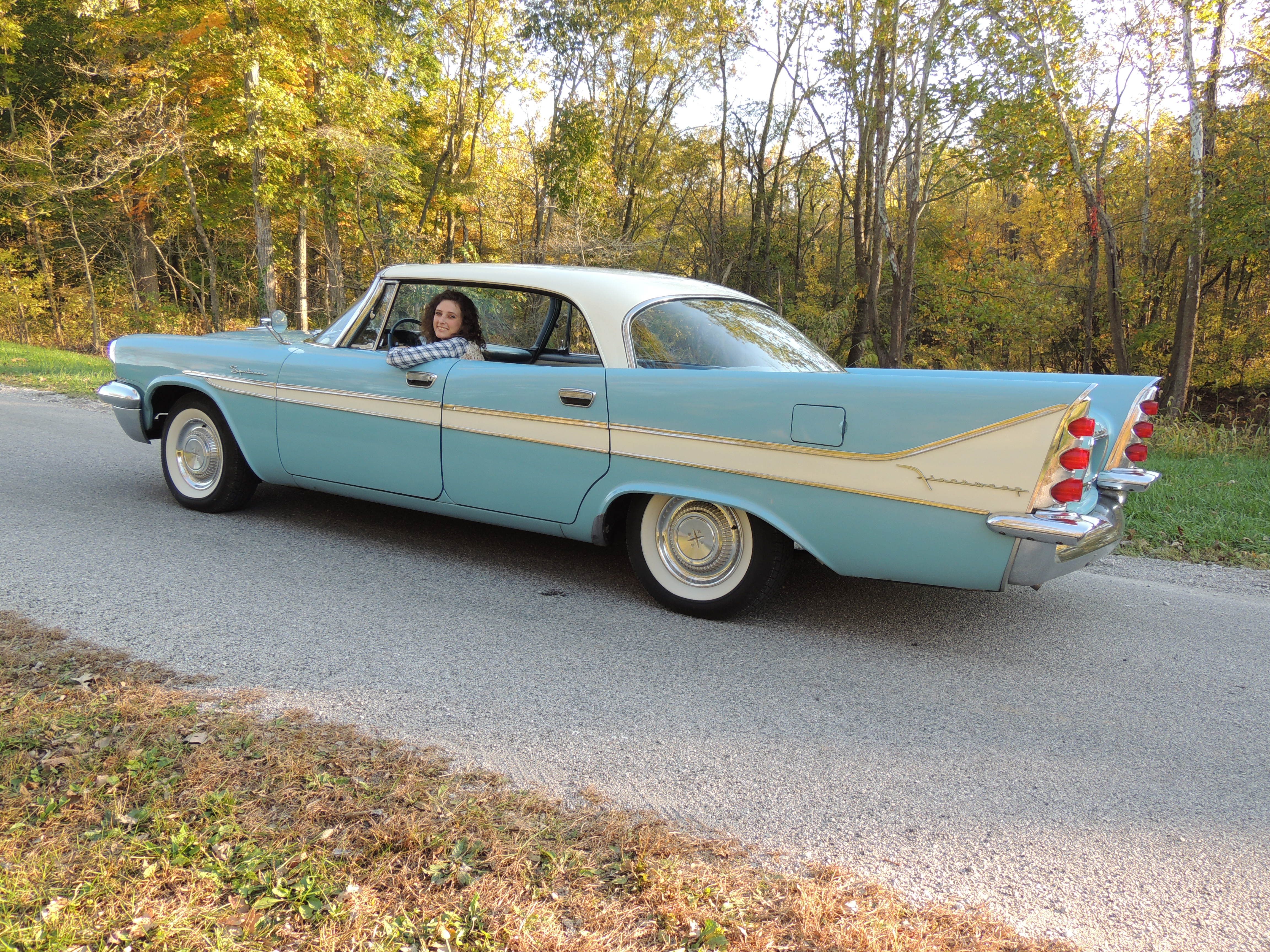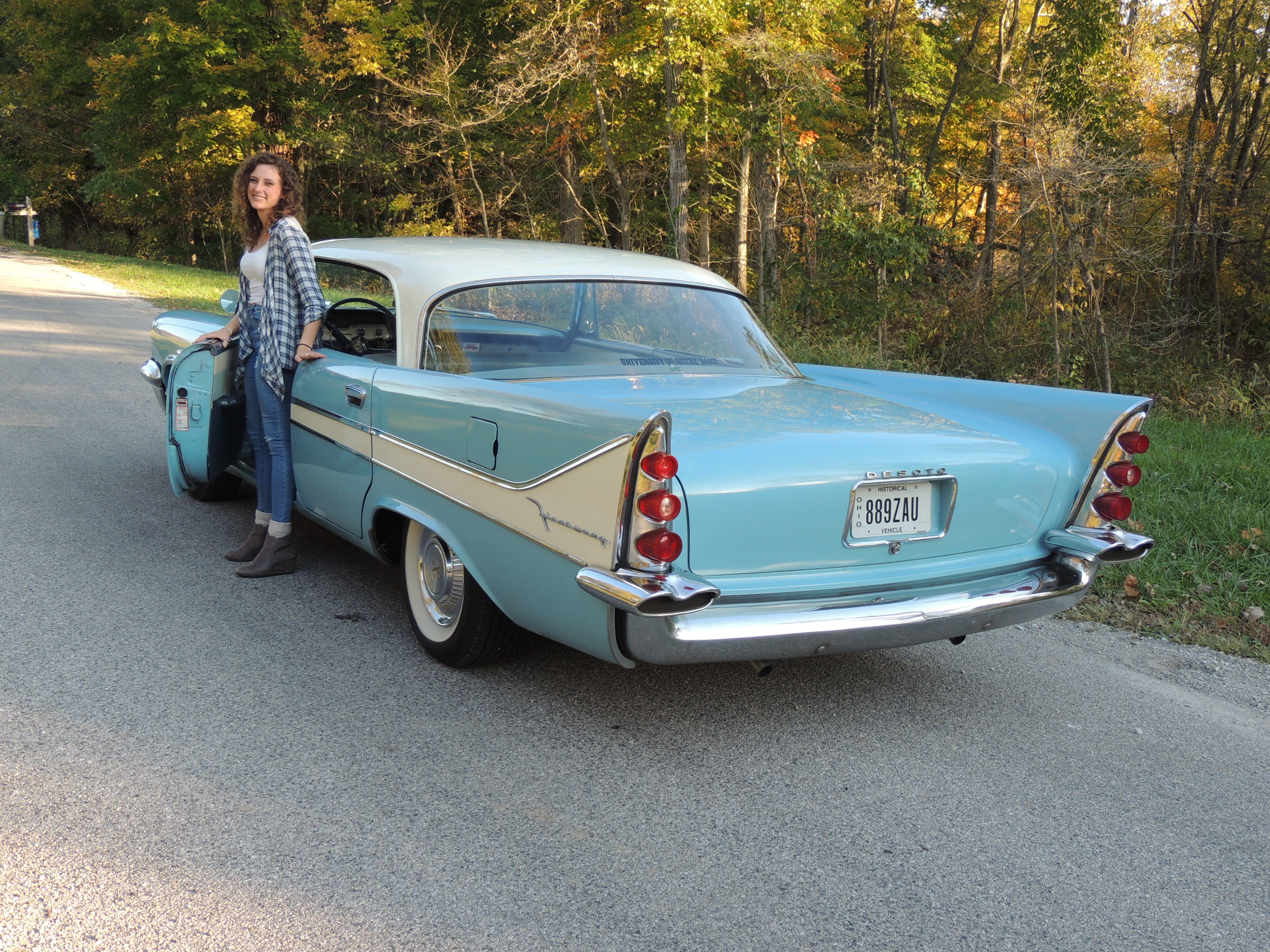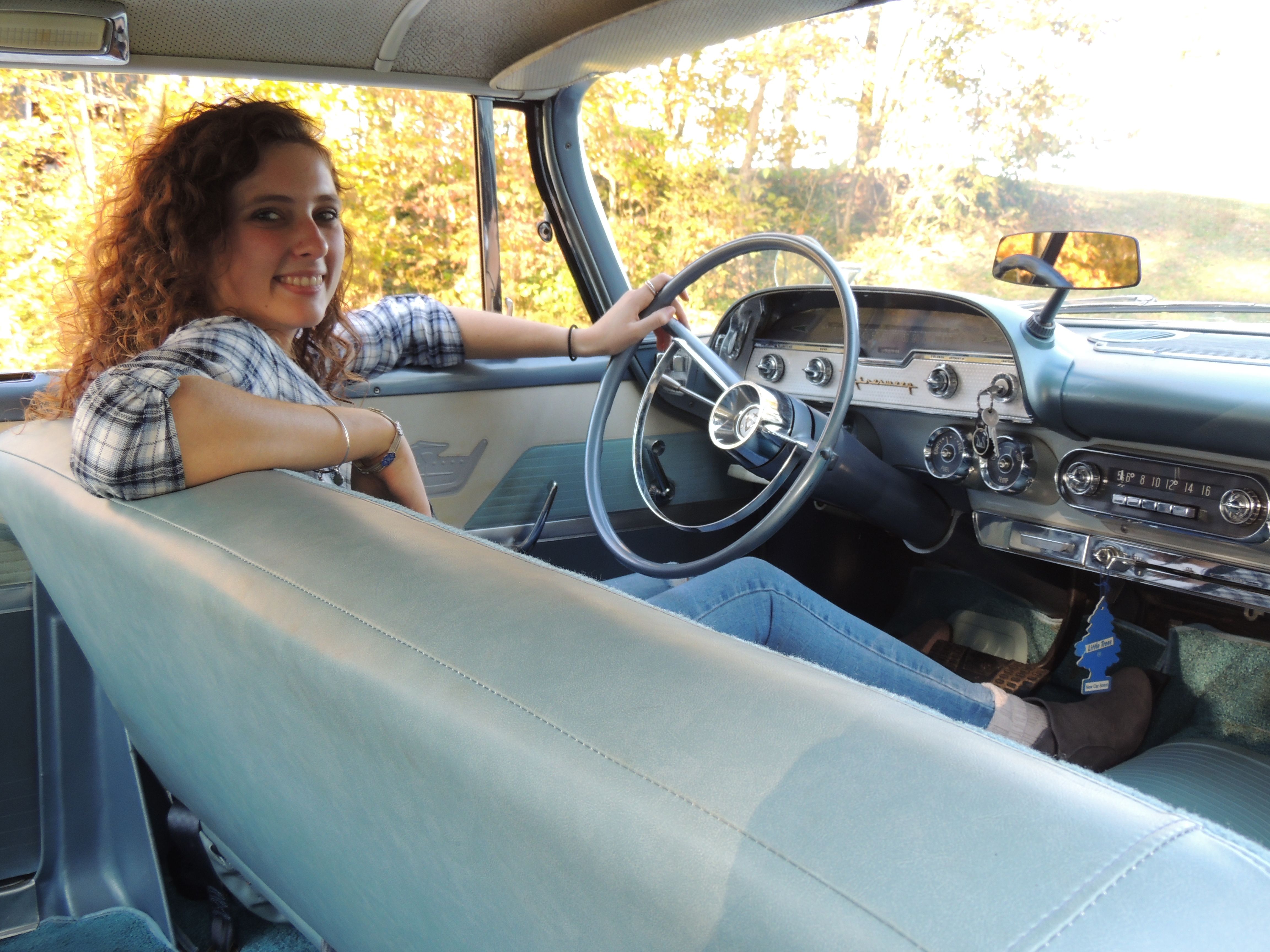The newfound joys of owning and driving a 1958 De Soto

[Editor’s note: This story and accompanying photos, edited by Richard Lentinello, comes to us from Christina Park.]
“SOLD!”
The booming, energetic voice makes my heart jump. My mind races into overdrive as I turn my head to look in the direction the auctioneer is pointing. There stands my father, hand raised, grinning at me like a child on Christmas morning. When I realize that I am grinning back at him in the same way, I can’t help but let out a giddy laugh. He reaches over and gives my shoulders a squeeze.
“She’s all ours,” he says, as if he knows that I can’t believe it. I step around the corner of the barn to take another look, possibly to reassure myself that I am not dreaming. I know I’m not as soon as I see the glint of metal in the chilly autumn sun. Its sleek body is covered in dust and grime, but the blue and white two-tone still mesmerizes me. The oversized grille flashes me a smile as the double headlamps return my awe-struck gaze.
“How does it feel,” my dad begins, knocking me out of a daze, “to be the proud new owner of a 1958 De Soto?” My heart is fluttering, and I can’t muster the words to answer him, so instead I throw my arms around him in a huge hug. He gives me a firm squeeze back, and then heads to the auction counter for the title. I help him load our new De Soto onto the trailer, and we head for home.
Throughout the next few months of frozen Ohio winter, my dad and I spend a few of our nights in the workshop with my De Soto. I tune the radio to an ’80s rock station that we both love as my dad pulls out tools and cleaning supplies. Being an eager seventeen-year-old, I immediately want to try to fire it up, but my dad disagrees, reminding me that diagnostics are most important. He lets me check and change the oil, something he taught me how to do a few years ago. While the oil is draining into the pan, I find myself gazing at the eighteen feet of art deco metal beside me, and my mind is quickly transported to a long-lost memory.

I am barely four years old, full of energy and spunk, and holding my father’s hand. I’m tugging him this way and that way, overwhelmed by the sea of shiny chrome and bright paint around me. All of the cars at this show seem so massive at my age, when I can hardly see in the windows without someone to boost me up. I am on the lookout for new favorites, carefully examining the cars and deciding which have the prettiest colors and the fanciest chrome. Suddenly, my eye is caught by something that is unlike any of the other cars in the show. I let go of my dad’s hand and run over to it, keeping in mind my parents’ teachings by being careful not to touch.
“Look!” I exclaim out of pure joy. “It’s for me!” I am standing next to a pedal car, the miniature replica of the show car next to it. It is indeed the perfect size for me, and I am completely amazed by its beauty. It has lots of chrome and is white, with a red two-tone sweep stretching down its side. As the memory fades, I recognize that same sweep right in front of me, this time white on sky blue. That pedal car was a ’58 De Soto, I remind myself. This car and I really are meant to be.
My dad, meanwhile, is bent under the hood, and he motions for me to hand him a socket. I do, leaning in with him as he tightens clamps and changes a few old and brittle hoses. As he finishes there, I grab a bottle of Turtle Wax and a rag and get to work on the dull paint and hazy chrome. After waxing the entire body, the chrome sparkles under the fluorescent lights, but much to my dismay, the paint is still a bit lackluster. When my dad sees my dejected face, he smiles, grabs a rag himself, and says: “Nothing a little elbow grease won’t fix!” I laugh, and we both start waxing again, taking our time and rubbing with all of our might. It takes us over an hour, and our arms are throbbing by the time we are finished, but the De Soto is now the color of a gorgeous summer sky, with a contrasting sweep as white as freshly fallen snow.
Over the next few weeks, we continue to tinker around under the hood, and before we know it, spring begins its struggle out of winter’s dreary grasp. My excitement climbs along with the temperatures because I know that my De Soto is nearly ready to take its first breath in a decade.
“Let’s start her up,” my dad says excitedly one spring day. I let out a happy little shriek and rush to pop the hood. My dad gets in the driver’s seat and instructs me to prime the engine with a little gas. My heart pounds as the engine turns over, and I send up a silent little prayer as it continues to crank. Almost immediately, it fires up and starts to idle with a smooth grumble.
“Yes!” I exclaim as I literally jump for joy. My dad shifts the transmission into gear, and backs out of the workshop, into the early spring sunshine. When the DeSoto is fully outside and engulfed in natural light, my heart nearly skips a beat. The colors are even more vibrant, the lavish chrome is flashing brightly, and the gorgeous tailfins are perfectly accented with their triple taillamps. My dad steps out and holds the door open. “Me?” I say hesitantly. “You want me to test drive it?” He nods, giving me that same giddy smile as before, only this time I see reassurance in addition to excitement. I slide in behind the wheel and shut the door with a satisfying chunk. My dad gets in the passenger seat, but he doesn’t need to instruct me; I’ve driven a few classics before. Everything already feels natural as I press my foot down hard on the brake pedal and release the parking brake. I push the button on the dash labeled D, and the transmission responds by shifting into gear. I shoot a quick glance at my dad, and he’s still smiling back at me. I ease off the brake, and we roll out the drive.
Once I pull out onto the road and gently nudge the De Soto up to speed, I am hit with a strong wave of nostalgia. It surprises me at first because I have never experienced anything like this before. I soon realize, though, that experience is not necessary for this feeling; all I need is an appreciation for the automobile I am driving. When I’m behind the wheel and feeling the smooth bounce of the shocks over the road, I can easily imagine that I’m driving in 1959, my car only a year old and still in style. “I Wonder Why,” by Dion and the Belmonts, is playing on the radio, and I am on my way to a busy drive-in theater or a cute sock hop diner. I’m rolling through the streets of downtown in its heyday, passing pristine classic cars that aren’t considered classics yet. Girls in long skirts are walking and laughing with guys in white tees with greased-back hair. These scenes are so strikingly clear in my mind that I could almost mistake them as memories.

Upon our return to the workshop, we deem the test drive a success, other than a sticky brake hanging up. My dad, a man with enough knowledge and experience to have a PhD in antique autos, reassures me that the problem will fix itself with more exercise. I eagerly take his advice to heart, and over the next few weeks, I drive my De Soto around the block every chance I get. Before I know it, I am getting to know my car, which is an experience that can only be fully understood after driving an old car. My De Soto has its own personality of sorts, a set of quirks that I quickly become familiar with. The manual drum brakes pull slightly to the left, a habit I have come to expect and correct without even thinking about it. The engine stumbles a bit when it’s cold and run too hard, so I always let it warm up first. Inside, the air circulates best and is quietest with all four windows down, instead of only the front two. I pick up on all of these things and more as I drive, forming a personal relationship with my car.
While most of these first drives are only a few short miles on little backroads, I still feel that same nostalgia while sitting in the driver’s seat. I refuse to listen to new music on the original radio, so I tune until I find a station of oldies rock-and-roll that matches my visions of the past. I find that when I’m driving, either alone or with others, there is not a care or worry in the world that could invade my thoughts. My spirits are high, and each time the whitewalls hit the pavement, I’m filled with a sense of freedom and bliss that I can’t quite explain. It is such a great escape to be behind the wheel of my De Soto that I never want to park and pull the key from the ignition.
A few weeks after that first test drive, spring begins its conversion to summer, and a new season of car shows begins. Entering my De Soto into its first show is exhilarating, and I receive many surprised looks from other participants, most of whom are old enough to be my parents and grandparents. Everyone wants to talk to me about my car.
“Does your dad let you drive that boat?”
“It’s yours?”
“You drive it with manual brakes?”
“Is this really your car?”
“Do you even know what a De Soto is?”
I take all of these questions with a grain of salt, knowing that it is a shock for most people to even see an interested young person at a car show, let alone one with a car of their own. I learn to enjoy the attention, and throughout the season I make many good friends, people that I would have had nothing in common with if not for my De Soto. The more shows I go to, the more familiar faces I recognize. I also don’t mind being surrounding by peers who are generations older than me. The more mature atmosphere gives me a new view of what friendships can be, and the countless stories I hear about good times with old cars are irreplaceable. Although I have enjoyed going to car shows as far back as I can remember, having my own car parked in the lineup and cruising it up and down the street is a whole new experience, and I find myself falling in love with both my car and classic car shows all over again.
That first summer and autumn with my De Soto go by in a flash. Soon, leaves litter the ground and the air takes on a permanent crispness that nips at my fingers and nose. When I look at the calendar, I am dismayed to find no more car shows, cookouts, or events to drive my car to. My father informs me that the time has come to store it away for the winter, in an insulated garage where nasty road salt cannot corrode the undercarriage and animals cannot hole up inside it to keep warm. I understand his reasoning, but the final drive across town to storage still pains me. The radio is still playing that old rock-and-roll station, and that familiar nostalgic twinge still emerges in my mind. I back into the garage space, turn off the engine, and step outside next to my dad. Before he rolls the door shut, I look back and notice the sun is angling in, illuminating the blue and white paint that will soon be accumulating five months of dust. The oversized grille winks brightly at me as my dad pulls down the door, and I smile back in spite of my emotions.
“Don’t be sad. I’ll see you again in the spring.” I hear the words in my head, but they could just as easily be coming from that curious flash of chrome. With that thought, I know that an automobile can be so much more than just a means of transportation. My De Soto is a time machine, a conversation starter, a hobby. Most of all, it is a companion, and our bond is as deep as the throaty rumble of the tailpipes.
SOURCE: Hemmings